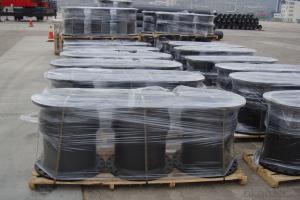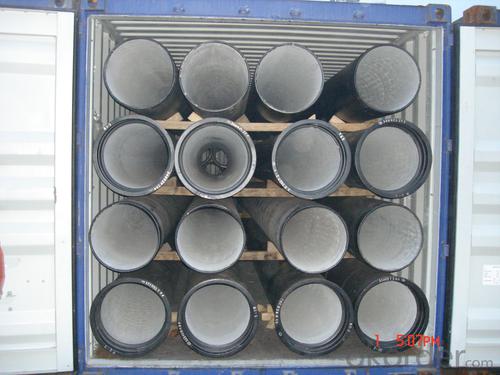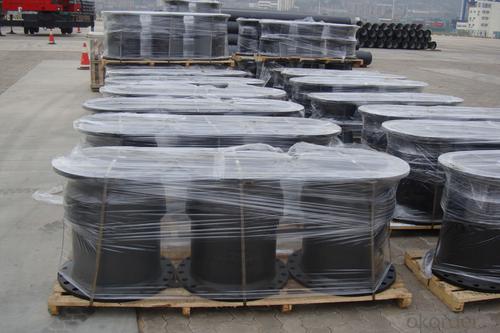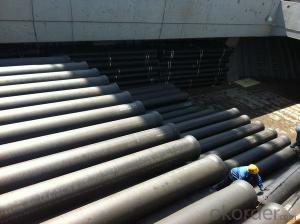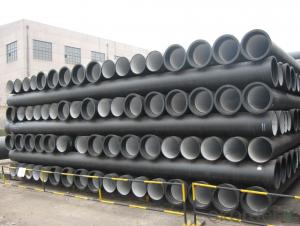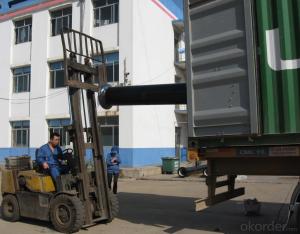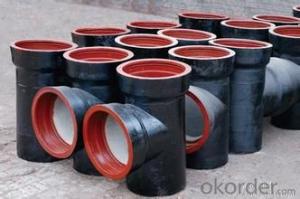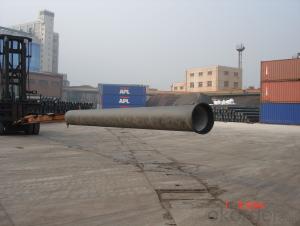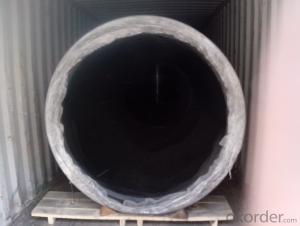DUCTILE IRON PIPES C Class DN1200
- Loading Port:
- China Main Port
- Payment Terms:
- TT OR LC
- Min Order Qty:
- -
- Supply Capability:
- -
OKorder Service Pledge
OKorder Financial Service
You Might Also Like
Ductile Iron Cast Pipe is without any defects compare with tradition casting tech, which has many advantages particularly as follow:
(1) High density. In the "vertical upward casting" process, the melt iron of centre liquid column in center crystallizer is continuously feeding for volume shrinkage caused by condensation tube at outer circumference , which lead to be free of shrinkage porosity.
(2) High purity. When melt iron pouring, the mixed impurities such as gas, dross, sand grain which are lighter than melt iron could be eliminated at furnace mouth, its impossible to enter into the crystallizer through the channel, so the melt iron into the crystallizer is very pure.
(3) Strength with toughness. The cooling speed provided by continuous crystallizer is 30 times than sand casting and 5 times than centrifugal casting, and doesn't produce white iron, the eutectic cell volume of continuous cast iron is one eighth to one tenth compare with traditional cast iron. The density of graphite nodule in ductile iron can reach 300-700 pcs/mm2. Therefore, all reason above improve the strength and toughness of continuous cast iron.
(4) Free machining. The high speed cooling make the hardening phase (such as boride, steadite) not appear like reticular, massive or thick, but diffuse like fish bone and pane in shape, moreover, there are tiny graphite flakes inlaid hardening phase. It's free machining in BrinellHardness the range of 250-300HB. However, the Brinell Hardness of 250 is top limit to common metal materials.
(5) Uniform composition of tube wall. The convection mixing of liquid column caused by marching type drawing in crystallizer make the composition of tube wall well-distributed, and concentration gradient very little.
(6) High productivity. To the wall thickness of tube under 10mm, the speed of continuous casting is 1 meter/min, to the wall thickness of tube under 20mm, the speed of continuous casting is 0.5 meter/min, which is high efficiency that centrifugal or other casting tech couldn't reach.
- Q: What new technologies are there for the installation of ductile iron pipes?
- At present, the international general no faucet pipe hoop straight pipe and fittings (i.e. new flexible joint cast iron drainage pipes and fittings of the thesis), according to the interface type is divided into A type flexible interface (flange gland connection) and type W (flexible interface coupling connection) two, referred to as A type and W type.1.1 new flexible joint cast iron drainage pipe by centrifugal casting technology, has a compact structure, pipe wall thickness, the outer wall is smooth, no trachoma and slag, the tensile strength and compressive strength are high, products with stable chemical composition, corrosion resistance, fire retardant non-toxic, comply with fire safety requirements of environmental protection, no noise, no deformation, life. Long use.Type 1.2A: type A tube with high strength, low noise, good fireproof performance, long service life, with the advantages of flexibility and good seismic performance, but in the actual project that socket joints need larger installation space and the tube body is heavy, consumption of steel, especially in high-rise buildings it is difficult to accept by construction.
- Q: Can ductile iron pipe be used for horizontal directional drilling?
- HDD, a trenchless method for installing underground utilities like pipelines, can indeed utilize ductile iron pipe. The choice of ductile iron pipe in HDD projects stems from its remarkable strength, durability, and ability to withstand the strains and stresses associated with directional drilling. It exhibits exceptional resistance to external loads and can endure the bending and pulling forces involved in HDD installations. Nevertheless, it is crucial to consider variables like pipe diameter, wall thickness, and soil conditions when selecting the appropriate pipe for HDD projects. Furthermore, it is imperative to adhere to proper installation techniques and take precautionary measures to ensure the long-term performance and integrity of ductile iron pipe in HDD applications.
- Q: How is ductile iron pipe installed?
- Ductile iron pipe is typically installed using a process called trenchless technology or open-cut method. In the trenchless technology approach, a hole is drilled into the ground and the ductile iron pipe is then pushed or pulled into the hole using hydraulic jacks or winches. This method minimizes disruptions to the surrounding environment and reduces the need for extensive excavation. In the open-cut method, a trench is excavated to the required depth and width for the ductile iron pipe. The trench is then prepared by removing any debris or obstructions and ensuring a stable base. The pipe is then lowered into the trench and aligned properly using laser or surveying equipment. After the pipe is positioned, joints are connected using a rubber gasket or mechanical joint. The joints are typically sealed to prevent leakage. Backfill material is then carefully placed around the pipe, ensuring proper compaction to provide stability and support. The backfill is typically done in layers to avoid excessive settlement. Once the installation is complete, the pipe is tested for leaks and pressure to ensure its integrity. This may involve hydrostatic testing, where the pipe is filled with water and monitored for any signs of leakage or pressure loss. Overall, the installation of ductile iron pipe requires careful planning, excavation, alignment, joint connection, backfilling, and testing. It is essential to follow industry standards and guidelines to ensure a successful and reliable installation that meets the required specifications.
- Q: Is the fire hose capable of using rapid repair joints?
- Clear。 Before installation, cleaning work should be carried out, the parts to be cleaned include: socket end, the mouth of the socket, the corner of the socket to the white line should be smooth, no sharp points, so as not to wear aprons when installation.
- Q: What's the advantage of FCD50 ductile iron?
- Ductile iron generally large diameter, pipe wall thickness, crisp texture, low strength, low price, is an economic water supply pipe, the normal service life of up to 20~25 years.
- Q: What are the different lining thickness options for ductile iron pipe?
- The specific application and project requirements typically dictate the various options for lining thickness in ductile iron pipes. Cement mortar lining, polyurethane lining, and polyethylene lining are among the most commonly used options. Cement mortar lining, which is widely employed in ductile iron pipes, involves the application of a layer of cement mortar on the inner surface of the pipe. This lining provides corrosion protection and enhances the hydraulic performance of the pipe. The thickness of cement mortar lining can vary from 3mm to 6mm. Polyurethane lining, another popular choice, is particularly suitable for applications requiring resistance to abrasion and chemical attack. It is usually applied using a spray or casting method, and the thickness can vary depending on project specifications. Typically, polyurethane linings range from 1mm to 4mm in thickness. Polyethylene lining, a relatively newer technology, is commonly used in applications where chemical corrosion resistance is crucial. The lining is applied using a rotational lining process, wherein a layer of molten polyethylene is evenly distributed on the internal surface of the pipe. The thickness of polyethylene lining can range from 2mm to 8mm, depending on project requirements. It is worth noting that the lining thickness can be tailored to meet specific project needs, including the corrosiveness of the transported fluid, operating conditions, and desired service life of the pipe. Consulting with a qualified engineer or pipe manufacturer is advisable to determine the most suitable lining thickness for a given application.
- Q: What are the recommended bedding and backfill materials for ductile iron pipe?
- To ensure proper alignment and prevent damage during installation and operation, ductile iron pipe requires a combination of granular materials such as sand, gravel, or crushed stone for bedding and backfill. Bedding involves using sand to create a level surface, distributing the load evenly and reducing stress concentration. As for backfill, it should be carefully selected to offer good compaction and drainage properties, preventing settling and potential damage. Common choices for backfill are crushed stone or gravel, which provide stability and allow for proper compaction. To ensure the long-term performance and durability of the pipe system, it is crucial to adhere to the recommendations of the pipe manufacturer and relevant industry standards when selecting bedding and backfill materials. These materials must meet specified size and quality requirements. Additionally, local regulations and soil conditions should also be considered when determining the appropriate bedding and backfill materials for ductile iron pipe installations.
- Q: What are the disadvantages of using ductile iron pipes?
- One disadvantage of using ductile iron pipes is their susceptibility to corrosion. Over time, exposure to moisture and various chemicals can cause the pipes to deteriorate and develop leaks. Another disadvantage is their relatively high cost compared to other pipe materials, such as PVC or HDPE. Additionally, ductile iron pipes are heavy and require specialized equipment for installation, which can increase labor and transportation costs.
- Q: What is the minimum cover requirement for ductile iron pipes?
- The minimum cover requirement for ductile iron pipes is typically determined by the specific project or engineering design considerations. However, as a general guideline, the minimum cover requirement for ductile iron pipes is often recommended to be at least 2 feet (or 0.6 meters) from the top of the pipe to the finished ground surface. This minimum cover requirement helps to provide adequate protection to the pipe from external loads, soil settlement, and potential damage from construction activities. It also helps to maintain the structural integrity and longevity of the ductile iron pipe system. It is important to note that local building codes, industry standards, and project specifications may dictate specific minimum cover requirements, so it is crucial to consult these resources for accurate and up-to-date information.
- Q: Can ductile iron pipes be used for rainwater harvesting systems?
- Yes, ductile iron pipes can be used for rainwater harvesting systems. Ductile iron pipes are known for their durability and strength, making them suitable for various applications, including rainwater collection and storage. They can effectively transport rainwater from collection points to storage tanks, ensuring a reliable and efficient rainwater harvesting system.
Send your message to us
DUCTILE IRON PIPES C Class DN1200
- Loading Port:
- China Main Port
- Payment Terms:
- TT OR LC
- Min Order Qty:
- -
- Supply Capability:
- -
OKorder Service Pledge
OKorder Financial Service
Similar products
Hot products
Hot Searches
Related keywords

